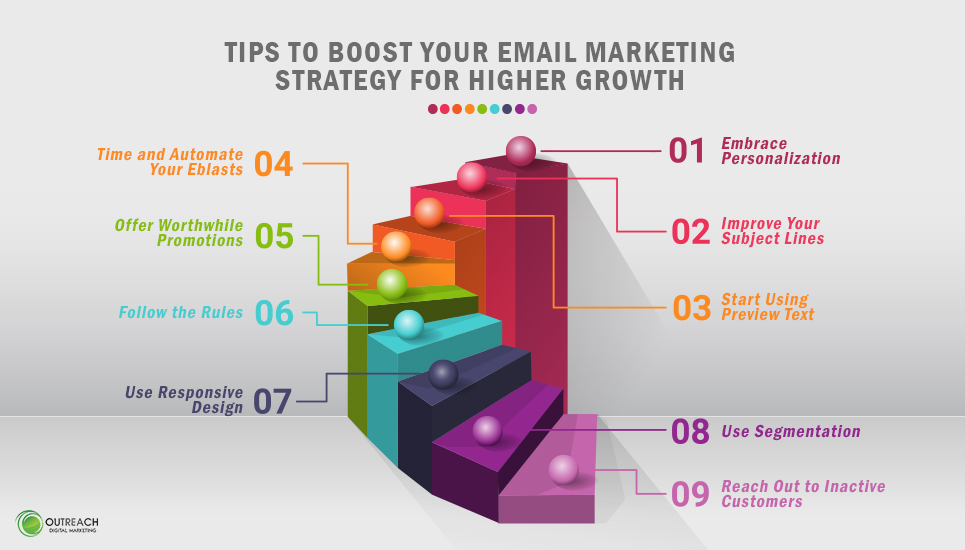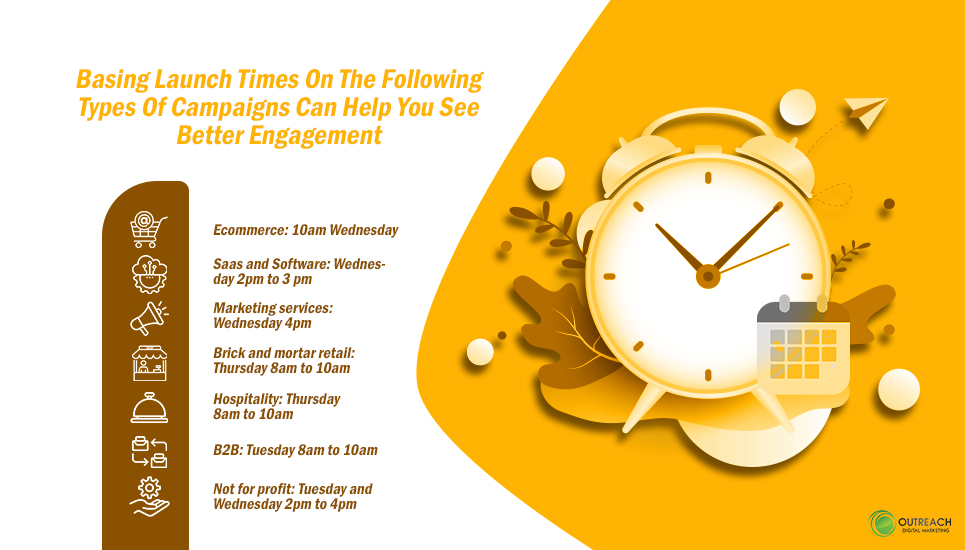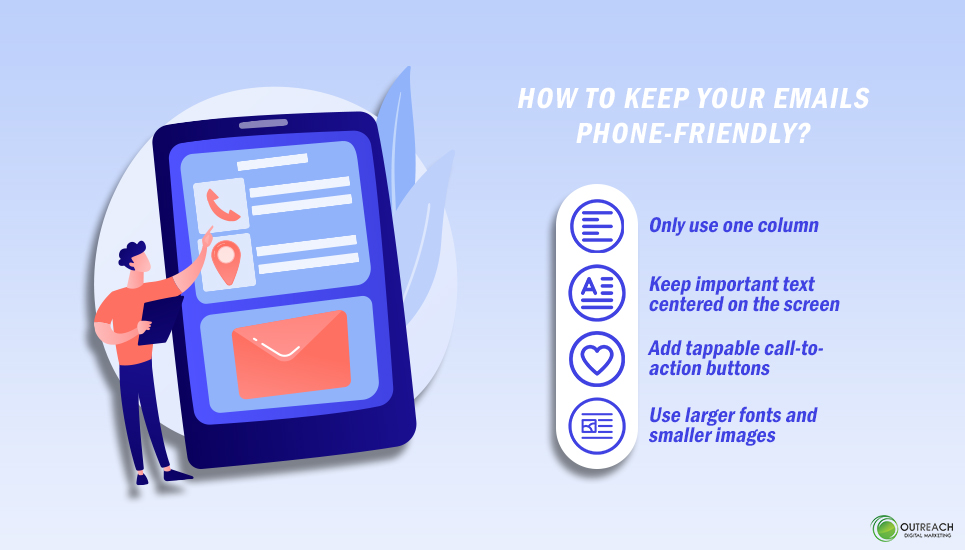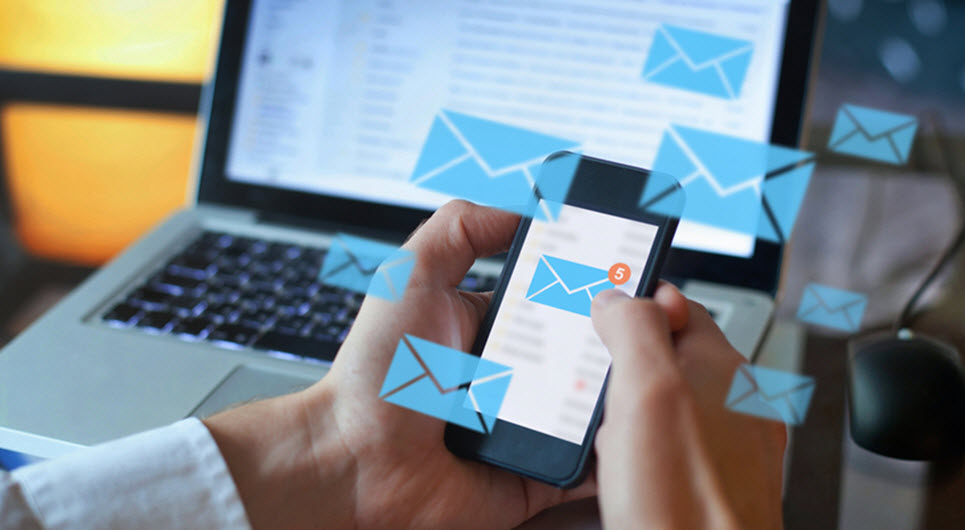Keeping your small business primed for growth requires ongoing communication with your customers and leads. If you’ve been depending on email marketing as part of your strategy for higher growth, but aren’t seeing the results you’d like, now is the time to do something about it. Here we offer tips to boost your email marketing strategy to improve click-through rates and grow your business.

Embrace Personalization
Email personalization increases open rates by as much as 29% over non-personalized emails. Additionally, 80% of the customers say they’d be more likely to make a purchase when brands provide personalized experiences. The trick is balancing that fine line between helpful and stalker-like behavior. Instead, leverage information such as a birthday to offer a special discount or gift.
Epson found that birthday-based emails generate a 342% higher ROI and have a 179% higher click rate than other types of promotional emails. You can also see an increase in transaction rates by 481%. Instead of just adding a name to the email, consider new ways to create meaningful experiences for customers that are personal and productive.
Improve Your Subject Lines
The great thing about subject lines is that you can test them over and over again to continuously improve outcomes. This is a practice used by digital marketing agencies. Since this is the first thing people see, it’s not surprising that 47% of emails are opened based on subject lines. Short and sweet subject lines that send an instant message are the best approach.
Something clever like the “Trip or Treat” campaign used by EF Tours was perfect for their fall travel promo. It’s easy to read and understand. Subject lines should have no more than six to 10 words if you want to improve open rates. Add to that a sense of urgency, and you can increase open rates even more.
Less is more when it comes to concocting your subject lines. Here are some tips to help finesse your subject lines:
- Create a sense of urgency
- Pique their curiosity
- Throw in an offer
- Personalize using segmentation (see below to learn more about segmentation)
- Ditch the no reply address in exchange for an actual person at your company
- A/B test to perfect your technique
- Don’t bury the lead, tell them what it’s all about
- Be concise, but interesting
- Create a sense of exclusivity
- Ask a question
- Be clever and humorous
- Avoid caps, exclamation points, and bold
Be purposeful with your subject lines so people feel action is required and you should see your engagement improve.
Start Using Preview Text
Give your subject lines a little help using intriguing preview text. Much like rich snippets for SERPs as part of your SEO strategy, this text appears near the subject line, providing an opportunity to include vital information. Email providers vary on what text is previewed, but it’s worth focusing on this copy to improve open rates. Email providers will add the preview text if you don’t provide it, so don’t leave things to chance.
Time and Automate Your Eblasts
People are finicky and moody. You want to reach them when they’re feeling a little more open, which means timing does impact your email campaign success. Although you won’t hit every inbox at the ideal time for every person on your mailing list, there are some common factors that make your timing more effective. Tuesday through Wednesday between 10am and 3pm tends to be the best overall timing. Basing launch times on the following types of campaigns can help you see better engagement:

- Ecommerce: 10am Wednesday
- Saas and Software: Wednesday 2pm to 3 pm
- Marketing services: Wednesday 4pm
- Brick and mortar retail: Thursday 8am to 10am
- Hospitality: Thursday 8am to 10am
- B2B: Tuesday 8am to 10am
- Not for profit: Tuesday and Wednesday 2pm to 4pm
Well-timed campaigns using automation allows you to test timing variants and create a dependable schedule to improve results.
Offer Worthwhile Promotions
What’s better than promotional giveaways to improve outcomes? The allure of the term “free” works to both collect more subscribers and increase click-throughs. Just be sure the offer doesn’t disappoint when subscribers land on the page to collect on the offer. Also, small business owners have to consider the cost of freebies to avoid eating into profit margins.
Follow the Rules
Following the rules ensures your emails aren’t marked as SPAM. The CAN-SPAM Act requires you to use relevant subject lines and include your commercial email address with an easy-to-find unsubscribe option. When collecting subscribers, you also have to always have an opt-out option.
Use Responsive Design
If you’ve ever received an email campaign not designed for your mobile phone, you know it is nothing but a pain. All email campaigns should use responsive design, so everything is readable on the smaller screen. Some tips to keep your emails phone-friendly include:

- Only use one column
- Keep important text centered on the screen
- Add tappable call-to-action buttons
- Use larger fonts and smaller images
As any digital marketing and SEP agency will tell you, high-quality, quick-to-load, and easy-to-read emails will always see better results and also reduce subscriber churn.
Use Segmentation
Your customers are at different levels of the funnel. You need to segment your emails to ensure you’re sharing information at the right time. Content is very important for all emails, and segmentation is the best way to ensure your content is right for each type of customer. As much as 58% of revenues are generated thanks to email segmentation. Your emails should make sense to a customer or subscriber.
For example, if someone just purchased a new phone, an email about how to make the most of the phone, app recommendations, or even a reminder to complete an online warranty makes sense. If the subscriber is a lead, sending a link to download a white paper or with more intense information about the products they are considering works. If someone has items in their shopping cart, a friendly reminder or even a special discount is ideal. The trick is to maximize engagement by remaining relevant. Common segments include:
- Active/Inactive customers
- Abandoned carts
- Types of purchases
- Customer journey position
- New subscribers
These segments help you personalize content, create segment-specific campaigns, and maintain an ongoing drumbeat through a more effective drip campaign strategy.
Reach Out to Inactive Customers
This is part of segmentation. Since about a quarter of your subscribers will unsubscribe each year, you have to try to reengage them before they opt out. Subscriber decay is a given, but you can reduce those numbers by reminding inactive customers why they subscribed in the first place.

You want to have a set period of inactivity that moves a subscriber from inactive to active. However, there are a few other things to consider when trying to reengage subscribers/customers:
- Type of Inactivity: Consider the different types of inactive subscribers. For example, a subscriber might engage with clicks but not be making purchases. It might be that they don’t log into their accounts or are making purchases but haven’t clicked through from emails for a set period of time. Decide why you consider them inactive.
- Your actions: Digging a little deeper from the above point, is there anything you are doing that could be leading to inactivity? Was there a drop-off in the number of emails you send? Have you stopped sending offers as opposed to just content? Is the content too generic? What actions did you take that saw a higher level of engagement with this subscriber? Were you maybe too aggressive? Did you bombard them with too many emails?
- Your Designs: We mentioned the importance of good design. Could you improve on your email designs to improve engagement? There’s no point in planning a re-engagement campaign if the emails will have the same ineffective designs.
- Your Approach: A re-engagement campaign should have the right approach to recapture subscriber attention. There’s the standard “we miss you” approach or upping the offers you send with better discounts. The key is to win inactive customers or subscribers back, which is hard to do if they have been ignoring you for several months. Since they haven’t chosen to unsubscribe, they could still be interested. Or they might just be too lazy to find the unsubscribe button. Either way, you still have their permission to send information, so you need to make sure what you send counts.
- Establish Email Preferences: If you find several attempts to get people to reengage fail, this is the time to try to establish their email preferences. Send a clear subject line like: Do You Still Want Our Emails? And then provide a link where they can update their email options. Keep in mind there’s nothing wrong with removing email addresses from your mailing list when someone is inactive. It cleans up your list and reduces eblast costs.
Although reaching out to inactive customers is never easy, the re-engagement campaign tends to see an average ROI of $28.50 for every dollar you spend. While it might take several tries to bring them back into the fold, the rewards are worth it. And remember the old marketing rule: It always costs less to market to inactive or existing customers than to find new ones.
When improving your email marketing strategy, keep testing. You can avoid repeat flops and continue to improve your campaigns for better and better results. These tips will provide the boost you need to see higher growth for your email campaign strategy so you can create loyal customers using a more personalized approach.
We continue to help small business owners of all kinds achieve their goals. Will you be next? Get in touch today.
